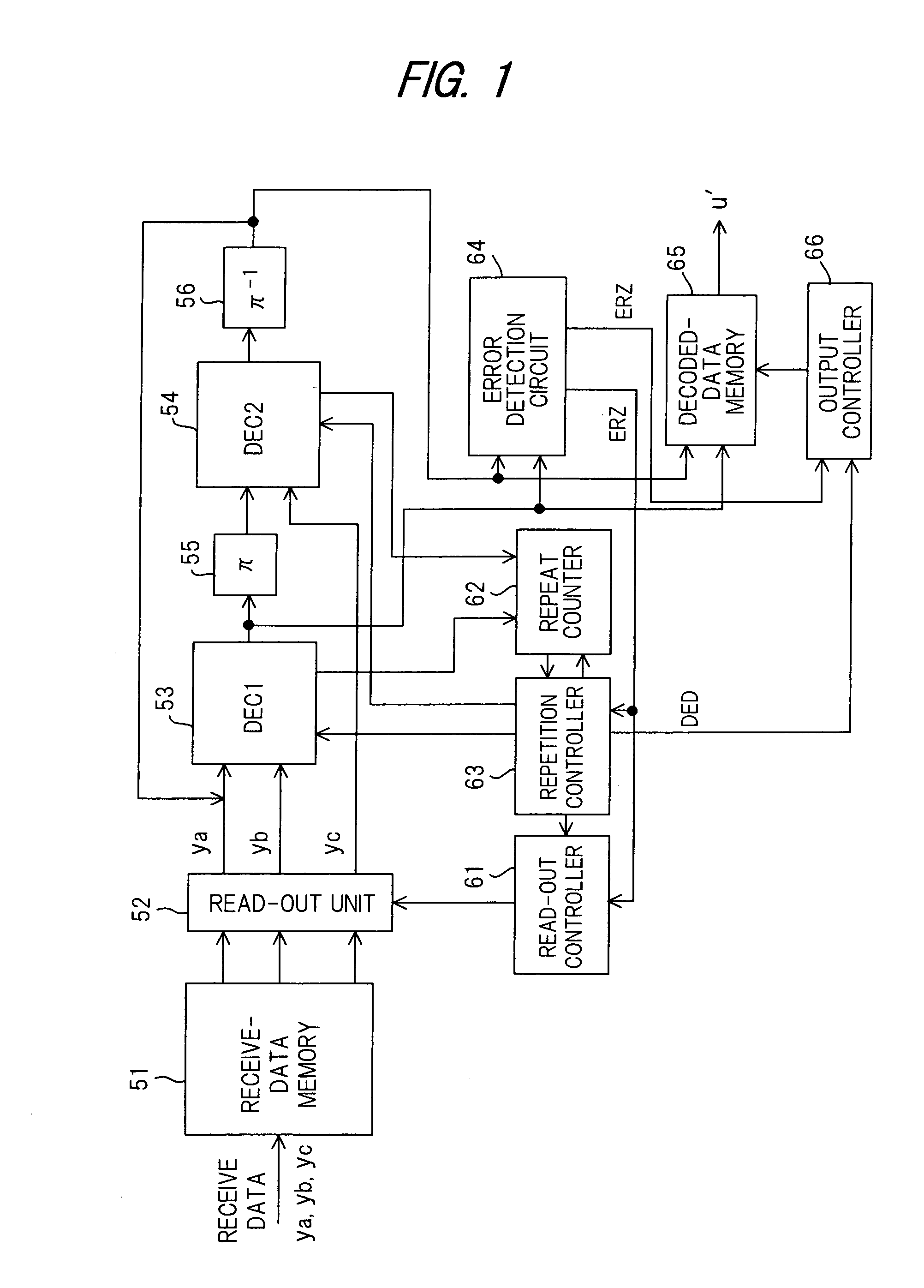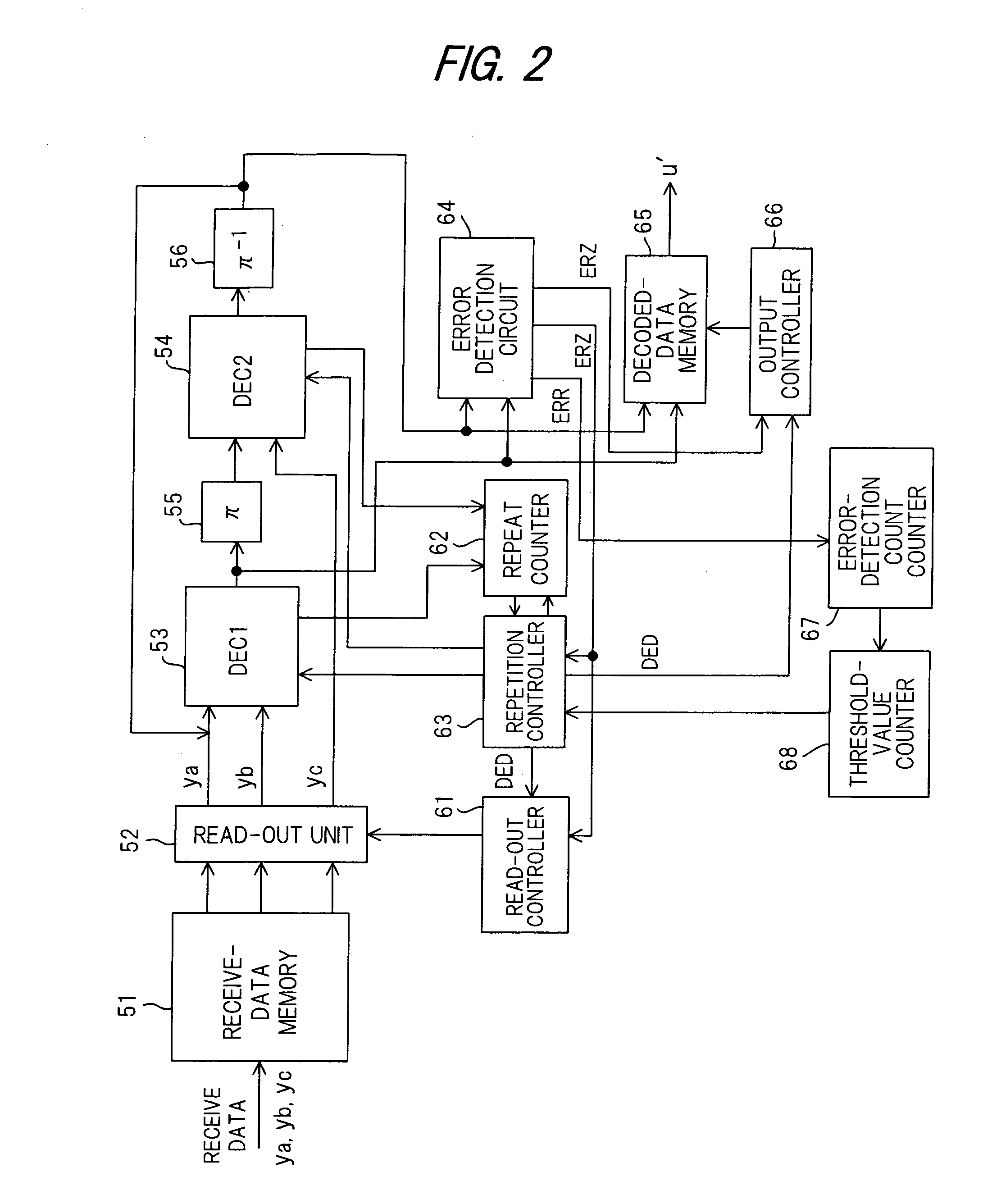Turbo decoder
a decoder and turbo technology, applied in the field of turbo decoders, can solve the problems of errors in the errors are corrected, and results of decoding decline errors, so as to reduce the error rate per information block, reduce the hardware, and reduce power consumption
- Summary
- Abstract
- Description
- Claims
- Application Information
AI Technical Summary
Benefits of technology
Problems solved by technology
Method used
Image
Examples
first embodiment
(b) MODIFICATION OF FIRST EMBODIMENT
[0060]The turbo decoder according to the first embodiment terminates the decoding operation and outputs the results of decoding prevailing at this time upon performing decoding the set number of times if errors have not been eliminated. However, there are instances where even though errors remain at the end of the set number of decoding operations, the number of errors is small and there is the possibility that all errors will be corrected if decoding processing is executed one more time. In such instances it is advantageous to perform the decoding operation one more time and output results of decoding that are error free. To accomplish this, a modification shown in FIG. 2 additionally provides the arrangement of the first embodiment with an error-detection count counter 67 and a threshold-value decision unit 68. The error detection circuit 64 outputs an error-detection signal ERR whenever an error is detected. The error-detection count counter 67...
second embodiment
(c) SECOND EMBODIMENT
[0064]FIG. 3 shows an embodiment of turbo decoder in which a single elementary decoder is adopted.
[0065]Here an elementary decoder 21 executes, in time-shared fashion, (1) the decoding processing (first half of decoding processing) that was performed by the first elementary decoder 53 of FIG. 1 using the received signals ya, yb and the results of the second half of decoding, and (2) the decoding processing (second half of decoding processing) that was performed by the second elementary decoder 54 of FIG. 1 using the received signal yc and the results of the first half of decoding. In other words, the timing of the decoding operation is divided into a first timing at which first (first half) decoding processing is executed and a second timing at which second (second half) decoding processing is executed, the first half of decoding processing is executed at the first timing and the second half of decoding processing is executed at the second timing.
[0066]A selecti...
third embodiment
(d) THIRD EMBODIMENT
[0071]In the prior art, as shown in (b) of FIG. 18, errors are dispersed over a plurality of information blocks, the error rate on a per-information-block basis increases and, if resend control is carried out in units of the information blocks, this results in an increase in number of resends. In a case where resend control is carried out, therefore, it is more advantageous for errors to be concentrated rather than dispersed. With convolutional encoding, the error pattern in the results of decoding by an elementary decoder is bursty in nature. This property is utilized to make it possible to output results of decoding directly without the intervention of interleaving or deinterleaving.
[0072]FIG. 4 is a block diagram showing a third embodiment of the present invention, in which an error generation pattern contained in results of decoding (decoded data) is rendered bursty.
[0073]An interleaver 30 interleaves the received signal ya and inputs the results to a first e...
PUM
 Login to View More
Login to View More Abstract
Description
Claims
Application Information
 Login to View More
Login to View More - R&D
- Intellectual Property
- Life Sciences
- Materials
- Tech Scout
- Unparalleled Data Quality
- Higher Quality Content
- 60% Fewer Hallucinations
Browse by: Latest US Patents, China's latest patents, Technical Efficacy Thesaurus, Application Domain, Technology Topic, Popular Technical Reports.
© 2025 PatSnap. All rights reserved.Legal|Privacy policy|Modern Slavery Act Transparency Statement|Sitemap|About US| Contact US: help@patsnap.com



